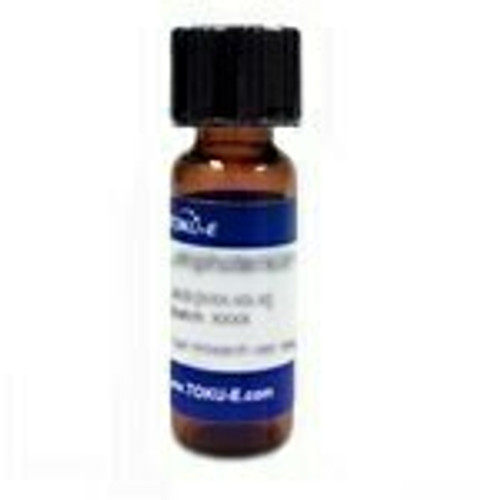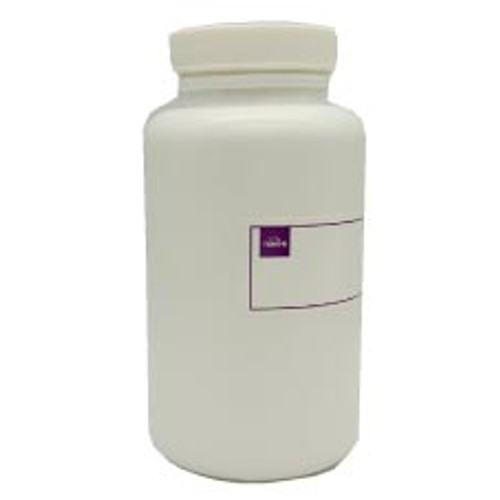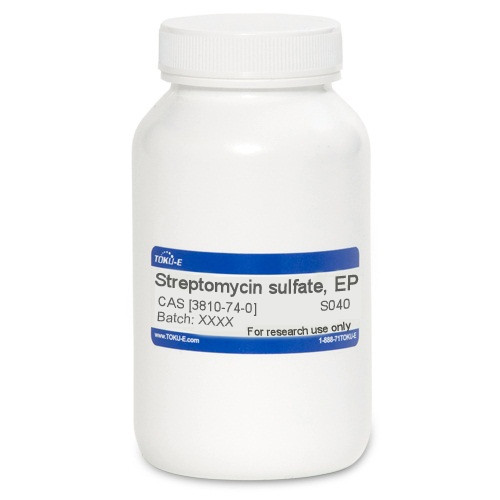Streptomycin, a metabolite of Streptomyces griseus, was first published as an antibiotic active against Gram-positive and Gram-negative bacteria by Schatz, Bugie and Waksman in 1944. Streptomycin was the first aminoglycoside antibiotic and first agent for tuberculosis. It was isolated by Albert Schatz in the laboratory of Selman Waksman (Rutgers) in a project funded by Merck and Co and Waksman was recognized with the Nobel Prize in Medicine for the discovery, with Albert Schatz also getting eventual recognition. It was the first aminoglycoside isolated from a bacterial source. After its discovery, several other aminoglyosides like Kanamycin, Neomycin and others were isolated from soil bacteria. Streptomycin is a bacterial protein synthesis inhibitor. Streptomycin is commonly used for bacterial gene selection and can be used as a selective agent in several types of isolation media.
Streptomycin is soluble in methanol or DMSO.
We also offer:
- Streptomycin Sulfate (S008)
- Streptomycin Sulfate, EP (S040)
- Streptomycin ReadyMadeTM Solution (S139)
- Streptomycin ReadyMadeTM EDTA Solution (S142)
| Molecular Formula | C21H39N7O12 |
| Spectrum | Streptomycin has broad-spectrum activity, with activity against most Gram-negative bacteria a few Gram-positive pathogens, along with Mycobacteria. |
| Mechanism of Action |
Streptomycin is a protein synthesis inhibitor. It binds to the small 16S rRNA of the 30S subunit of the bacterial ribosome irreversibly, interfering with the binding of formyl-methionyl-tRNA to the 30S subunit. This leads to codon misreading, eventual inhibition of protein synthesis and ultimately death of microbial cells through mechanisms that are still not understood. Speculation on this mechanism indicates that the binding of the molecule to the 30S subunit interferes with 50S subunit association with the mRNA strand. This results in an unstable ribosomal-mRNA complex, leading to a frameshift mutation and defective protein synthesis leading to cell death. |
| Microbiology Applications |
Streptomycin is commonly used for bacterial gene selection with the aadA resistance gene. Common working concentration is 50 – 100 µg⁄ml. Media Supplements STAA Agar - STAA Selective Supplement STA Agar - STA Selective Supplement Streptomycin is commonly used in clinical in vitro microbiological antimicrobial susceptibility tests against Gram-positive and Gram-negative microbial isolates. Medical microbiologists use AST results to recommend antibiotic treatment options. Representative MIC values include:
Streptomycin can be used in tuberculosis research. It is active against tubercle bacilli, located extracellularly. It is not active against bacilli located inside the infected cells (intracellular bacilli). |
| Plant Biology Applications |
Streptomycin has been used in crop protection to prevent fire blight in applies and pears, soft rot caused by Pectobacterium species, bacterial blight caused by Pseudomonas cichorii, and bacterial spot in peppers and tomatoes caused by Xanthomonas spp. (McManus et al. 2002). Streptomycin resistance (SmR) is a global problem and is critical in plant disease management as there are few alternatives to Streptomycin. |
| Cancer Applications |
Streptomycin down-regulates miR-21, a miRNA overexpressed in a number of cancers that has been linked to cellular proliferation, apoptosis, and migration. It binds to pre-miRNA (its precursor) and blocks the function of the Dicer enzyme, an essential step in miRNA maturation (Bose et al, 2012). |
| References |
Bose D et al (2012) The tuberculosis drug Streptomycin as a potential cancer therapeutic: Inhibition of miR-21 function by directly targeting its precursor. Angew Chem. Int. Ed. Engl. 51(4):1019-1023 PMID 22173871 Luzzatto L et al (1968) Mechanism of action of Streptomycin in E. coli: Interruption of the ribosome cycle at the initiation of protein synthesis. Proc. Nat. Acad. Sci.60:873 PMID 4875806 Schatz A, Bugie E and Waksman SA (2005) Streptomycin, a substance exhibiting antibiotic activity against Gram-positive and Gram-negative bacteria. 1944 Clin. Orthop Relat. Res. 537:3-6 PMID 16056018 |







